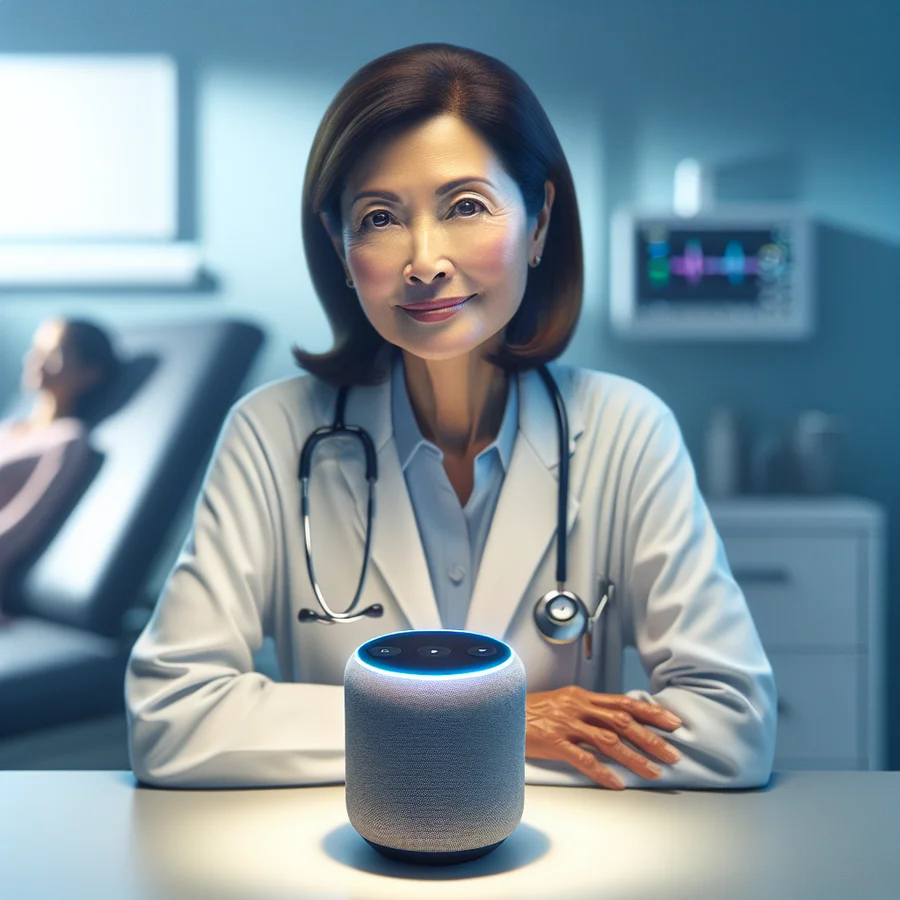Voice AI in Healthcare: Reducing Workloads and Enhancing Patient Care
Imagine a world where doctors and nurses spend less time on paperwork and more time caring for patients. That world is becoming a reality with voice AI in healthcare. This technology is revolutionizing the industry, offering solutions to reduce workloads, improve patient experiences, and enhance overall care quality.
This guide explores how voice AI is transforming healthcare. We’ll look at its applications, benefits, and the future it promises. Discover how this technology can help healthcare professionals focus on what matters most: their patients.
Understanding the Power of Voice AI in Healthcare
Voice AI in healthcare is more than just a futuristic concept. It’s a practical solution addressing real challenges. It uses technologies like Natural Language Processing (NLP) and Machine Learning (ML) to understand and respond to human speech.
This technology allows healthcare professionals and patients to interact with systems using their voice. This hands-free approach can save time, reduce errors, and improve efficiency in various healthcare settings.
What is Voice AI?
Voice AI refers to the use of artificial intelligence to enable computers to understand, interpret, and respond to human voice commands. Think of it as giving your computer a pair of ears and a mouth, allowing it to listen and speak like a person.
In simple terms, it’s the technology that powers voice assistants like Siri and Alexa, but tailored for the specific needs of the healthcare industry.
Key Components of Voice AI Systems
Several key technologies work together to make voice AI systems function effectively:
- Automatic Speech Recognition (ASR): ASR converts spoken words into text. It’s the foundation that allows the system to “hear” and understand what’s being said.
- Natural Language Processing (NLP): NLP helps the system understand the meaning and context of the spoken words. It goes beyond simple transcription to interpret the intent behind the message.
- Text-to-Speech (TTS): TTS converts digital text back into spoken words. This allows the system to “speak” and provide responses to the user.
- Machine Learning (ML): ML algorithms allow the system to learn from data and improve its accuracy over time. The more the system is used, the better it becomes at understanding and responding to voice commands.
These components work together to create a seamless and intuitive voice-based interface for healthcare applications.
How Voice AI Works in Healthcare Settings
In a hospital or clinic, voice AI can be used in many ways. Imagine a doctor using voice commands to update a patient’s electronic health record (EHR) during an examination. Or a nurse using a voice assistant to order medication or request lab tests.
Patients can also benefit from voice AI. They can use voice commands to schedule appointments, request prescription refills, or access health information. This can be especially helpful for elderly or disabled patients who may have difficulty using traditional interfaces.
The Benefits of Voice AI in Healthcare: Enhancing Efficiency and Care
Voice AI in healthcare offers a multitude of benefits. These advantages impact not only healthcare professionals but also patients and the overall healthcare system.
Reducing Administrative Workload
One of the most significant benefits of voice AI is its ability to reduce the administrative burden on healthcare professionals. Nurses, for example, spend a significant portion of their time on documentation and paperwork.
Note: Studies show that nurses can spend between 20% and 35% of their shifts on administrative tasks.
Voice AI can automate many of these tasks, freeing up nurses and doctors to focus on patient care. Voice-enabled documentation tools allow clinicians to dictate notes and update patient records using voice commands. This eliminates the need for manual data entry, saving time and reducing errors.
Improving Accuracy and Reducing Errors
Manual data entry is prone to errors. Voice AI can improve accuracy by reducing the reliance on manual processes. Voice recognition technology can accurately transcribe spoken words into text, minimizing the risk of errors.
Additionally, voice AI systems can be integrated with EHRs and other clinical databases. This integration ensures that information is automatically updated and readily available, reducing the risk of inconsistencies and discrepancies.
Enhancing Patient Experience
Voice AI can significantly enhance the patient experience. By automating routine tasks, it reduces wait times and allows healthcare professionals to spend more time interacting with patients. This can lead to increased patient satisfaction and improved health outcomes.
Reminder: Patients value personalized attention and clear communication. Voice AI can help healthcare professionals deliver both.
Voice AI can also provide patients with convenient access to health information and services. Patients can use voice commands to schedule appointments, request prescription refills, or access educational materials. This empowers patients to take a more active role in their healthcare.
Improving Communication and Collaboration
Effective communication is essential in healthcare. Voice AI can improve communication and collaboration among healthcare teams. Voice-enabled communication tools allow clinicians to quickly and easily share information with each other.
For example, a doctor can use voice commands to send a message to a nurse or specialist, requesting a consultation or sharing important patient information. This can streamline workflows and improve the coordination of care.
Increasing Efficiency and Productivity
By automating routine tasks, reducing errors, and improving communication, voice AI can significantly increase efficiency and productivity in healthcare settings. This allows healthcare professionals to see more patients, provide better care, and reduce costs.
Note: Increased efficiency can lead to improved financial performance for healthcare organizations.
Supporting Remote Patient Monitoring
Voice AI plays a crucial role in remote patient monitoring. It enables healthcare providers to monitor patients’ conditions remotely, collect vital data, and provide timely interventions. This is especially beneficial for patients with chronic conditions or those recovering from surgery.
Through voice-enabled devices, patients can report symptoms, track medication adherence, and receive personalized health advice from the comfort of their homes. This technology enhances patient engagement, reduces hospital readmissions, and improves overall health outcomes.
Real-World Applications of Voice AI in Healthcare
Voice AI is already being used in a variety of healthcare settings. These real-world applications demonstrate the potential of this technology to transform the industry.
Clinical Documentation
One of the most common applications of voice AI is in clinical documentation. Doctors and nurses can use voice commands to dictate notes, update patient records, and complete other documentation tasks. This saves time and reduces the risk of errors.
For example, BayCare, a healthcare system in Florida, is using Aiva Health’s Nurse Assistant, which leverages voice commands on iPhones to streamline clinical documentation. Nurses report that this technology eliminates the need to move computers between patient rooms and facilitates real-time charting at the bedside.
Appointment Scheduling and Reminders
Voice AI can automate appointment scheduling and reminders. Patients can use voice commands to schedule appointments, reschedule appointments, or request reminders. This reduces the workload on administrative staff and improves patient adherence to treatment plans.
Example: Conversational AI systems can send automated reminders to patients for upcoming appointments, minimizing no-show rates.
Medication Management
Voice AI can assist with medication management. Patients can use voice commands to request prescription refills, check medication dosages, or access information about their medications. This improves medication adherence and reduces the risk of errors.
Example: AI-powered assistants can provide personalized reminders tailored to individual treatment schedules, ensuring patients stay on track with their medications.
Patient Education
Voice AI can provide patients with access to educational materials and resources. Patients can use voice commands to ask questions about their health conditions, treatment options, or medications. This empowers patients to take a more active role in their healthcare.
Example: AI-powered assistants can offer tailored wellness recommendations based on a patient’s medical history, promoting proactive health management.
Virtual Assistants
Virtual assistants powered by voice AI can provide 24/7 support to patients. These assistants can answer frequently asked questions, provide information about healthcare services, or connect patients with the appropriate resources. This reduces the workload on healthcare staff and improves patient satisfaction.
Example: AI chatbots can help patients quickly identify next steps for urgent care, providing emergency assistance outside of regular clinic hours.
Mental Health Support
Voice AI is also being used to provide mental health support. AI-powered chatbots can engage users in conversations that help assess their emotional state, offering coping strategies or self-care tips. These tools can recognize signs of serious mental health concerns and escalate cases to mental health professionals when necessary.
Example: Woebot is an AI-based mental health chatbot that provides cognitive behavioral therapy (CBT) techniques, helping users manage anxiety, depression, and stress through personalized conversations.
Veterinary Clinics
The benefits of voice AI extend beyond human healthcare. Veterinary clinics are also leveraging this technology to improve operational efficiency and patient care. Voice-controlled tools allow veterinarians to access patient histories, dictate examination notes, and order diagnostic tests hands-free.
Example: During surgeries, hands-free technology enables veterinary staff to adjust lighting or retrieve diagnostic images using voice commands, ensuring a more efficient and hygienic workflow.
Implementing Voice AI in Healthcare: Key Considerations
Implementing voice AI in healthcare requires careful planning and consideration. Several factors must be addressed to ensure successful adoption and maximize the benefits of this technology.
Data Privacy and Security
Protecting patient privacy and data security is paramount. Healthcare organizations must comply with regulations like HIPAA (Health Insurance Portability and Accountability Act) and GDPR (General Data Protection Regulation). This means implementing strong security measures to protect patient data from unauthorized access and disclosure.
Reminder: Use two-factor authentication, encrypted communication channels, and conduct regular audits to ensure data security.
Integration with Existing Systems
Voice AI systems must be seamlessly integrated with existing healthcare systems, such as EHRs and billing systems. This integration ensures that information is automatically updated and readily available, reducing the risk of errors and improving efficiency.
Note: Partnering with experienced vendors that understand healthcare interoperability standards is key to successful integration.
User Training and Adoption
Healthcare professionals need proper training to use voice AI systems effectively. This training should cover the basics of voice commands, as well as more advanced features and functionalities. It’s also important to address any concerns or resistance to change that healthcare professionals may have.
Reminder: Provide ongoing support and resources to help healthcare professionals adopt voice AI into their daily workflows.
Accessibility and Inclusivity
Voice AI systems should be accessible to all patients, regardless of their language, digital skills, or economic background. This may involve providing multilingual support, user-friendly interfaces, and assistive technologies for patients with disabilities.
Note: Regularly evaluate voice AI tools for bias and effectiveness to ensure fairness and inclusivity.
Cost and Return on Investment
Implementing voice AI requires an initial investment in hardware, software, and training. Healthcare organizations must carefully evaluate the costs and benefits of this technology to determine whether it’s a worthwhile investment. Consider the long-term cost savings, efficiency gains, and improvements in patient care that voice AI can provide.
Reminder: Focus on the ROI of reduced administrative costs, improved patient satisfaction, and better health outcomes.
The Future of Voice AI in Healthcare
The future of voice AI in healthcare is bright. As technology continues to evolve, we can expect to see even more innovative applications of this technology. Generative AI, personalized interventions, and public health insights will redefine how we support frontline staff.
Generative AI
Generative AI is poised to revolutionize healthcare by summarizing patient records instantly. This will cut down on time wasted and reduce mental overload for nurses and doctors. Hospitals implementing generative AI-powered clinical documentation tools have reported a 30% reduction in time spent on patient notes.
Note: Generative AI must be fine-tuned for healthcare settings, ensuring accuracy and compliance with FHIR and HIPAA standards.
Personalized Interventions
Advanced voice AI-powered tools are being designed to proactively support nurses’ mental and physical health. These tools will track biometric data and work history to recommend optimal break times and shift rotations. Personalized stress reduction apps will tailor interventions, whether it’s mindfulness exercises, physical activity recommendations, or even just reminders to hydrate.
Example: Some hospitals are testing AI-assisted VR simulations that offer immersive stress relief, taking nurses out of the hospital—without them leaving the break room.
Predictive Analytics
Predictive analytics will play an increasingly important role in healthcare. Voice AI systems can analyze patient data to identify individuals at risk of developing certain health conditions. This allows healthcare providers to intervene early and prevent serious health problems.
Example: AI algorithms can analyze shift lengths, workload intensity, and sleep patterns to forecast when a nurse is at risk of burnout, allowing for dynamic workload adjustments.
Wearable Integration
The integration of voice AI with wearable devices will enable continuous monitoring of patient health. Wearable sensors can collect data on vital signs, activity levels, and sleep patterns. This data can be analyzed by voice AI systems to provide personalized health recommendations and alerts.
Example: Wearables integrated with AI analytics can monitor heart rate variability (HRV), sleep patterns, and activity levels to detect early signs of stress in nurses.
Telehealth Expansion
Voice AI will continue to play a crucial role in expanding access to telehealth services. Patients can use voice commands to connect with healthcare providers, access medical information, and receive remote monitoring and support. This is especially important for patients in remote areas or with limited mobility.
Example: Telehealth platforms can use voice AI to provide virtual consultations, medication reminders, and personalized health advice to patients in their homes.
Voice AI in Healthcare: Reducing Workloads and Enhancing Patient Care Conclusion
Voice AI in healthcare is revolutionizing the way healthcare is delivered. It’s improving efficiency, reducing workloads, and enhancing patient care. By automating routine tasks, improving accuracy, and enhancing communication, voice AI is helping healthcare professionals focus on what matters most: their patients.
As technology continues to evolve, we can expect to see even more innovative applications of voice AI in healthcare. The future is bright, and voice AI is poised to play a central role in transforming the industry.
Frequently Asked Questions (FAQs)
What are the primary benefits of using voice AI in healthcare?
Voice AI offers numerous benefits, including reduced administrative workload, improved accuracy, enhanced patient experience, better communication and collaboration, and increased efficiency and productivity. It also supports remote patient monitoring and provides 24/7 patient support.
How does voice AI improve patient care?
Voice AI improves patient care by automating routine tasks, reducing wait times, and allowing healthcare professionals to spend more time interacting with patients. It also provides patients with convenient access to health information and services, empowering them to take a more active role in their healthcare.
What are some real-world applications of voice AI in healthcare?
Real-world applications include clinical documentation, appointment scheduling and reminders, medication management, patient education, virtual assistants, mental health support, and applications in veterinary clinics.
What are the key considerations for implementing voice AI in healthcare?
Key considerations include data privacy and security, integration with existing systems, user training and adoption, accessibility and inclusivity, and cost and return on investment.
What is the future of voice AI in healthcare?
The future of voice AI in healthcare includes generative AI, personalized interventions, predictive analytics, wearable integration, and telehealth expansion. These advancements will further enhance efficiency, reduce workloads, and improve patient care.
How does voice AI help reduce nurse burnout?
By automating routine administrative tasks, voice AI allows nurses to focus on high-value activities, reducing workload stress and promoting a healthier work environment. This is essential for retaining skilled professionals in the industry.
Can voice AI assist with mental health support?
Yes, voice AI can provide mental health support through AI-powered chatbots that engage users in conversations to assess their emotional state, offering coping strategies or self-care tips. These tools can also recognize signs of serious mental health concerns and escalate cases to mental health professionals when necessary.






